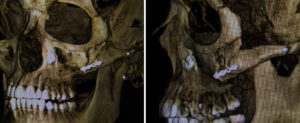The widest part of the face in most people is controlled by the lateral projection of the zygomatic arch. It is uncommon that the width of the temples or the jawline exceeds that of the zygomatic arches in the midface. The zygomatic body almost always sits inside the maximum width of the convexity of the zygomatic arch.

All known variations of these cheekbone osteotomies works by moving the existing curve of the arch inward, not by changing the shape of the zygomatic arch. It has always seemed that if the shape of the arch can be changed that would be just as effective as moving the whole arch inward at its ends.
In the December 2014 issue of the Aesthetic Surgery Journal, article appeared entitled ‘Zygomatic Arch Reduction and Malarplasty with Multiple Osteotomies: Its Geometric Considerations’. In this paper, a new technique for facial width reduction is presented by making multiple osteotomies and a central bone resection at the middle part of the most protruding part of the zygomatic arch. The amount of bone resection was calculated with a geometrical solution according to the desired reduction rate of the arch height. A 3D CT scan was used to calculate arch height and the length of arch bone that needed to be removed. A central piece of bone was removed from the most protruding point of the zygomatic arch on each side. Greenstick fractures were made at the anterior and posterior roots of the zygomatic arch. The open arches were rotated inwardly until the resected bone met.
Their results in an impressive over 1,000 zygomatic arches were reduced from 3 to 11mms. Amazingly all reduced zygomatic arches healed with solid bony unions. Patient satisfaction with this technique was very high. The success of this cheekbone reduction method is based on changing the shape of the zygomatic arch. Knowing how much bone to remove is the key so that the zygomatic arch ends fall together and meet. That is provided by a simplified geometrical calculation.
Is the central arch resection better than the traditional medial arch displacement technique? In many facial width reduction patients it may not be necessary. But for those with a very convex zygomatic arch shape, changing the shape of the arch is the only way to get a really significant facial width reduction.
Dr. Barry Eppley
Indianapolis, Indiana


